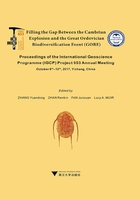
Geographic Disparity of Graptolite Faunas During the Late Katian Biodiversification Event
1 CAS Key Laboratory of Economic Stratigraphy and Palaeogeography, Nanjing Institute of Geology and Palaeontology, Nanjing 210008, China; qchen@nigpas.ac.cn;
2 State Key Laboratory of Palaeobiology and Stratigraphy, Nanjing Institute of Geology and Palaeontology, Chinese Academy of Sciences, Nanjing 210008, China; fanjunxuan@gmail.com;
3 Laboratory for Marine Geology, Qingdao National Laboratory for Marine Science and Technology, Qingdao 266061, China.
1 Introduction
Ordovician graptolite macroevolution can be divided into several stages; for each stage, the major clade involved was different (Chen et al., 2006; Sadler et al., 2011). The last radiation of the graptolite fauna in the Ordovician occurred in the late Katian, and mainly influenced the Dicranograptidae, Climacograptidae, Diplograptidae and Lasiograptidae clades. Although this biodiversification event was interrupted by the end-Ordovician mass extinction, it was still important in graptolite macro-evolutionary history (Chen et al., 2005a; Fan & Chen, 2007).
In South China, late Katian graptolites are mostly found in the Wufeng Formation, which is typical carbonaceous and siliceous black shale, and usually less than 10 m thick. The graptolite fauna in the Wufeng Formation has been studied for decades, usually focusing on the graptolite systematics (Mu, 1945; Mu et al., 1993; Chen et al., 2005b), biostratigraphy (Chen et al., 2000) and bioevents (Fig. 1; Chen et al., 2005a; Fan et al., 2013).
In the present study, we use Geographic Information System (GIS) techniques to depict the geographic disparity of the graptolite fauna based on occurrence data to reveal the spatial patterns of graptolite macroevolution during the radiation.
2 Materials and methodology
The graptolite occurrence data of 49 sections were collected from the GBDB Database (http://www.geobiodiversity.com/). All the graptolite occurrences were revised based on a unified systematic classification scheme. The study area (latitude 24°-34°N, longitude 101°-121°E) was divided into 50 cells (Fig. 2), each of which is 2°×2°. We combined the graptolite occurrences of sections from the same cell together to avoid the influence of sampling incompleteness. Then we measured the similarity of graptolite assemblages between any two cells using the program-specific and architecture-specific (PAlaeontological STatistics, PAST), as demonstrated in Fig. 2.

Figure 1 Stratigraphic subdivision of the Wufeng Formation and the graptolite richness curve during the interval. The graptolite richness curve is modified from Fan et al. (2013). KYC, Kuanyinchiao Bed; LMC, Lungmachi Formation.
3 Discussion
During the late Katian, taking the Dicellograptus complexus Biozone as an example, all the cells can be divided into two types: cells of the deeper-water region and cells of the shallow-water region. Usually the species richness of cells in the deeper-water region (The number of cells >20) are higher than those of the shallow-water region (The number of cells <15). The graptolite assemblages of the cells of the deeper-water region show higher similarities between themselves, and those in the shallow-water region exhibit relatively lower similarities. However, the assemblages of the two regions commonly show very low similarities, usually less than 0.3. The results indicate an apparent geographic differentiation in the graptolite fauna during the late Katian radiation in South China, which was probably influenced by water depth.
Acknowledgements This work was supported by the National Natural Science Foundation of China (Nos. 41521061, 41502025), the Chinese Academy of Sciences (Nos. XDPB05, XDB10010100) and the China Geological Survey Project (No. 2016-03019). This is a contribution to the “Geobiodiversity Database” and IGCP Project 653.

Figure 2 Similarity of graptolite assemblages between 2°×2° cells in the D. complexus Biozone. Diamonds indicate the cells that have valid graptolite occurrence data; the numbers beside them are the numbers of cells. Cells with an orange background are deep-water regions; those with green background are shallow-water regions.
References
Chen, X., Rong, J. Y., Mitchell, C. E., Harper, D. A. T., Fan, J. X., Zhan, R. B., Zhang, Y. D., Li, R. Y., Wang, Y. 2000. Late Ordovician to earliest Silurian graptolite and brachiopod biozonation from the Yangtze region, South China, with a global correlation. Geological Magazine, 137(6): 623—650.
Chen, X., Melchin, M. J., Sheets, H. D., Mitchell, C. E., Fan, J. X. 2005a. Patterns and processes of latest Ordovician graptolite extinction and recovery based on data from South China. Journal of Paleontology, 79(5): 841—860.
Chen, X, Fan, J. X., Melchin, M. J, Mitchell, C. E. 2005b. Hirnantian (latest Ordovician) graptolites from the upper Yangtze region, China. Paleontology, 48(2): 1—47.
Chen, X., Zhang, Y. D., Fan, J. X. 2006. A brief introduction to the evolutionary radiation of Ordovician graptolites. In: Rong, J. Y., Fang, Z. J., Zhou, Z. H., Zhan, R. B., Wang, X. D., Yuan, X. L., (eds.), Originations, Radiations and Biodiversity Changes—Evidences from the Chinese Fossil Record. Beijing: Science Press, pp. 181-196, 856.
Fan J. X., Chen, X. 2007. Preliminary report on the Late Ordovician graptolite extinction in the Yangtze region. Palaeogeography, Palaeoclimatology, Palaeoecology, 245(1-2): 82—94.
Fan, J. X., Chen, Q., Melchin, M. J., Sheets, H. D., Chen, Z. Y., Zhang, L. N., Hou, X. D. 2013. Quantitative stratigraphy of the Wufeng and Lungmachi black shales and graptolite evolution during and after the Late Ordovician mass extinction. Palaeogeography, Palaeoclimatology, Palaeoecology, 389: 96—114.
Mu, A. T. 1945. Graptolite fauna from the Wufeng Shale. Bulletin of the Geological Society of China, 25: 201—209.
Mu, E. Z., Li, J. J., Ge, M. Y., Chen, X., Lin, Y. Q., Ni, Y. N. 1993. Upper Ordovician Graptolites of Central China Region, Palaeontologia Sinica (B29). Beijing: Science Press (in Chinese with English summary).
Sadler, P. M., Cooper, R. A., Melchin, M. J. 2011. Sequencing the graptoloid clade: building a global diversity curve from local range charts, regional composites and global time-lines. Proceedings of the Yorkshire Geological Society, 58(4): 329—343.